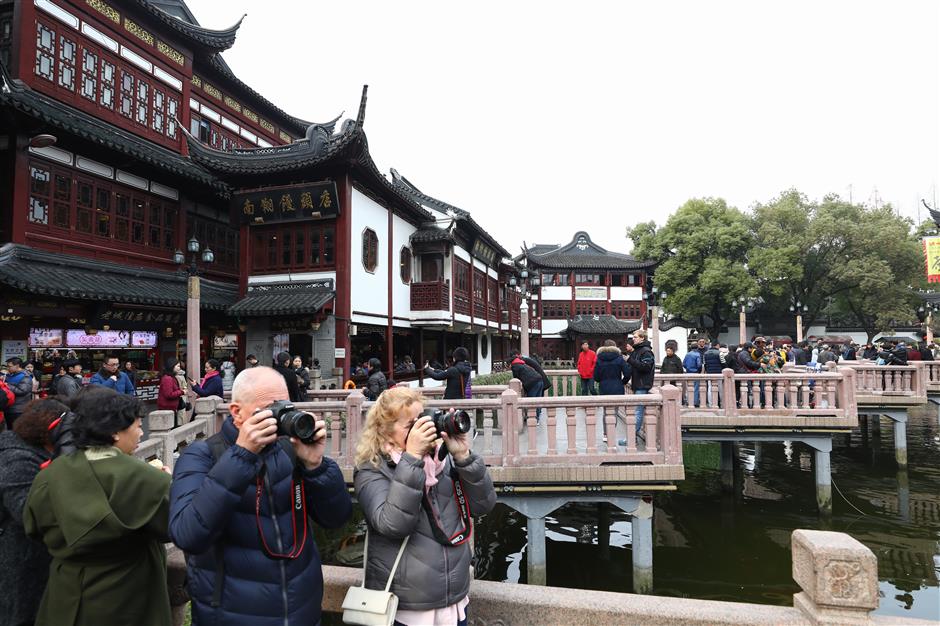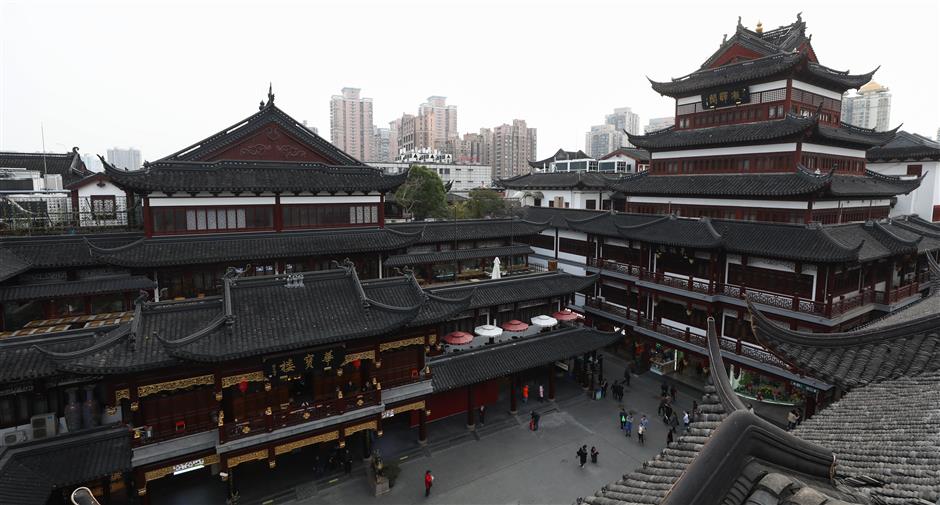New round of facelifts at Yuyuan

Two foreign tourists take pictures at Yuyuan Garden yesterday. The dining and shopping facilities near the historic garden are undergoing a new round of makeovers to upgrade its dining options while highlighting local cultural heritage.
Shanghai's iconic Yuyuan Garden commercial malls are undergoing a new round of makeovers to mainly upgrade its dining options while highlighting local cultural heritage.
The traditional restaurants near the Jiuqu Zigzag Bridge will be redecorated. The upper stories of five buildings which now mostly serve as management offices will open to the public and there's a possibility they may be connected by a skywalk.
The Yuyuan Tourist Malls, the dining and shopping facilities near historic Yuyuan Garden, originates from a prosperous market of the City God Temple some 140 years ago. A previous facelift in 1992 built many current traditional buildings covering an area of 53,000 square meters, and home to restaurants and jewelry, traditional Chinese medicine and souvenir stores.
The malls receive 40 million visitors every year as an iconic tourist attraction. But its dining and commercial facilities have been lagging behind, while more upper-level space can be developed and open to visitors, according to Yuyuan Inc, the owner of the commercial properties and a subsidiary of Fosun.
"The first phase of the facelift campaign has started to create three new major attractions," said Xu Xiaoliang, Yuyuan Inc's chairman. They include the core dining options, along with "promenade" and "upper-level" experiences. The makeover aims to make the Yuyuan malls a cultural brand of Shanghai, being both classic and fashionable, Xu said.
There's also a plan to develop an old residential neighborhood beside the garden into a commercial and shopping complex. Details are not yet available.
The core area of the malls features the Lubolang and the Nanxiang steamed bun restaurants, two famous dining brands of Shanghai. The Lubolang restaurant originated in the Ming Dynasty (1368-1644) and has catered for many national leaders. The Nanxiang restaurant often has long queue of diners eager to try its signature steamed buns with crab roe.

Yuyuan Garden commercial malls
However, they look just as they did two decades ago.
The plan is to preserve the exterior of both buildings while the inner structures will be redecorated.
The history of both restaurants will be featured, while more interactive facilities added to attract families.
Many surrounding small eateries will be replaced.
Tourists had long complained about some of the eateries for their bad service and substandard food.
A "promenade experience" will be created to guide tourists along a designated route. The practice is expected to improve the visitor experience, while ensuring a better flow of pedestrian traffic.
Currently, the malls are accessible through eight entrances and people often linger about with no clear idea of where to go, which made the area always looks crowded, an official with the management company said.
The upper levels of the five tower buildings at the malls — mainly Huabao, Tianyu and Hefeng — will open to visitors to create new visiting experiences as well as to distribute the large number of tourists during festivals.
A trial operation has been launched at the Huabao building, once a popular market for antiques and stamps, but now a lot quieter with the rise of the online antique market.
The second floor of the building is being converted into an exhibition space for local-style nianhua, or Chinese New Year painting, which originated at the garden nearly a century ago. An exhibition of historic paintings which illustrate what the city's old town and Yuyuan market looked like early last century will open in January.
A teahouse and stage for traditional Chinese operas have opened on the fourth floor of the Hefeng Building with rooftop gardens, stone pavilions and rosewood furniture. It is operating based on group reservations with Kunqu Operas to be performed on the stage.
There was a private opera stage at the site when Pan Yunduan , a high-level government official during the Ming Dynasty, built Yuyuan Garden in 1559 as a gift to his parents.
The garden was listed as a national heritage site by the State Council in 1982.















